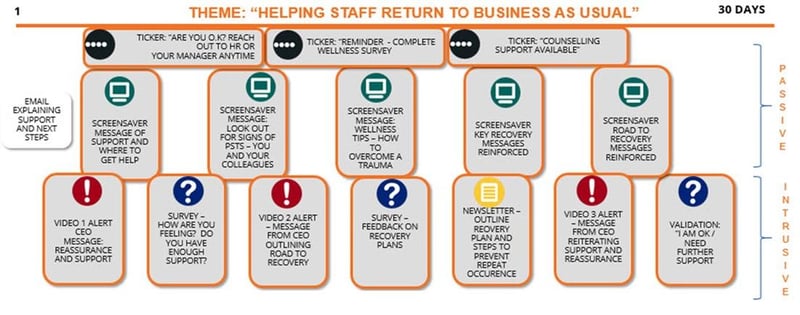From over 10 years of experience in internal communications, working with lots of different customers and partners, there’s one piece of advice I’d give above all others.
That’s to take a campaign approach in your employee communications. By that, I mean taking a more strategic or holistic view of end-to-end communication.
It’s what I call 360-degree campaigns. And here’s why it’s more important than ever in today’s noisy, info-overloaded business world.
What are 360-degree campaigns?
As an internal communications manager, you need a complete view of the whole employee engagement process, from beginning to end. In addition, you must have oversight of what staff needs to know or feel at each stage. That might be the awareness they need to have, behavior they should adopt, or specific action they need to take.
To help achieve this mindset, consider questions like what action you’re looking to drive, what staff need to know to support this, what messages you need to send to achieve this, what timings you need to use, and so on.
When you know this, you can then begin to align your messaging and implementation to target each stage and drive the outcome you need. Focus on the “long-game” – think strategically – but optimize every opportunity you have to connect with staff in an engaging way.

Example 360-degree communication mix for emergency comms - during the event
Why do they matter?
These 360-degree campaigns are an important approach because they give managers and executives the greatest ability to truly get employee attention and engage with staff.
In doing this, they are able to embed the intent of the communications into the culture and behavior of the organization, to then drive the change or direction they want.
At a fundamental level, this approach mimics human communications. We tell stories, we engage in conversation, and we learn and adapt over time based on our reaction to different stimuli. Organizations evolve because their employees’ behaviors and motivations change. In my view, the catalyst for organizational evolution has to be the journey of employee communications.
How do they work in practice?
At a tactical level, a multi-channel approach, using the right tools for the right job at the right time, is the most effective way to communicate.
Conveying the vision and direction of an organization, for example, and linking this back to individual teams and their contributions, is not something that can be articulated in an effective and engaging way via a single email or group chat.
Using a 360-degree campaign-based approach, highly visual channels such as screensavers, wallpapers, and lock screens can be used to set the scene and build general awareness.
High-visibility desktop alerts can deliver important updates and key information when 100% reach and readership are required (this is something the SnapComms solution can uniquely measure and guarantee).
Opportunities for feedback can be obtained via staff surveys while understanding the adoption of behavior change assessed through quizzes.
That’s what we refer to as the communication spectrum – channels for every business objective, from passive to priority. It’s particularly important in today’s world of both dispersed and diverse workforces.
 Example 360-degree communication mix for emergency comms - following the event
Example 360-degree communication mix for emergency comms - following the event
Why are they so effective?
This 360-degree approach underscores the importance of the frequency of messages to drive outcomes. These channels and others should ideally be used with varying frequency throughout the year to keep employees updated and informed, reinforce the message and directive, and promote employee engagement.
It’s the same philosophy as you see in consumer advertising campaigns, where there’s the marketing ‘rule of 7’ adage which states that people need to see a message seven times before action is taken.
The challenge is not to bombard staff with floods of emails. That would be counterproductive.
This is where the value of the 360-degree communication strategy really proves its worth. They work because employees find the messages relevant and engaging, and employers can use them to directly grow business performance.
For me, 360-degree campaigns are the future of internal communications. The organizations which embrace this approach will be the ones to win the hearts and minds of their staff.

